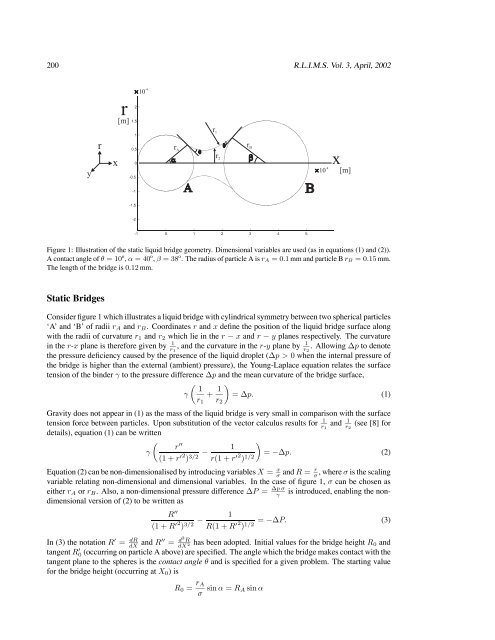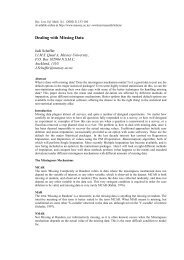Mathematical Modelling of Granulation: Static and Dynamic Liquid ...
Mathematical Modelling of Granulation: Static and Dynamic Liquid ...
Mathematical Modelling of Granulation: Static and Dynamic Liquid ...
Create successful ePaper yourself
Turn your PDF publications into a flip-book with our unique Google optimized e-Paper software.
200 R.L.I.M.S. Vol. 3, April, 2002<br />
Figure 1: Illustration <strong>of</strong> the static liquid bridge geometry. Dimensional variables are used (as in equations (1) <strong>and</strong> (2)).<br />
Acontact angle <strong>of</strong> θ =10 o , α =40 o , β =38 o .The radius <strong>of</strong> particle A is rA =0.1 mm <strong>and</strong> particle B rB =0.15 mm.<br />
The length <strong>of</strong> the bridge is 0.12 mm.<br />
<strong>Static</strong> Bridges<br />
Consider figure 1 which illustrates a liquid bridge with cylindrical symmetry between two spherical particles<br />
‘A’ <strong>and</strong> ‘B’ <strong>of</strong> radii rA <strong>and</strong> rB. Coordinates r <strong>and</strong> x define the position <strong>of</strong> the liquid bridge surface along<br />
with the radii <strong>of</strong> curvature r1 <strong>and</strong> r2 which lie in the r − x <strong>and</strong> r − y planes respectively. The curvature<br />
in the r-x plane is therefore given by 1<br />
1<br />
,<strong>and</strong>thecurvature in the r-y plane by .Allowing ∆p to denote<br />
r1 r2<br />
the pressure deficiency caused by the presence <strong>of</strong> the liquid droplet (∆p >0 when the internal pressure <strong>of</strong><br />
the bridge is higher than the external (ambient) pressure), the Young-Laplace equation relates the surface<br />
tension <strong>of</strong> the binder γ to the pressure difference ∆p <strong>and</strong> the mean curvature <strong>of</strong> the bridge surface,<br />
<br />
1<br />
γ +<br />
r1<br />
1<br />
<br />
=∆p. (1)<br />
r2<br />
Gravity does not appear in (1) as the mass <strong>of</strong> the liquid bridge is very small in comparison with the surface<br />
tension force between particles. Upon substitution <strong>of</strong> the vector calculus results for 1 1 <strong>and</strong> (see [8] for<br />
r1 r2<br />
details), equation (1) can be written<br />
<br />
<br />
1<br />
γ<br />
= −∆p. (2)<br />
r ′′<br />
(1 + r ′2 ) 3/2 −<br />
r(1 + r ′2 ) 1/2<br />
Equation (2) can be non-dimensionalised by introducing variables X = x<br />
r<br />
σ <strong>and</strong> R = σ ,where σ is the scaling<br />
variable relating non-dimensional <strong>and</strong> dimensional variables. In the case <strong>of</strong> figure 1, σ can be chosen as<br />
either rA or rB. Also, a non-dimensional pressure difference ∆P = ∆pσ<br />
γ is introduced, enabling the nondimensional<br />
version <strong>of</strong> (2) to be written as<br />
R ′′<br />
(1 + R ′2<br />
) 3/2 −<br />
1<br />
R(1 + R ′2 = −∆P. (3)<br />
) 1/2<br />
In (3) the notation R ′ = dR<br />
dX <strong>and</strong> R′′ = d2R dX2 has been adopted. Initial values for the bridge height R0 <strong>and</strong><br />
tangent R ′ 0 (occurring on particle A above) are specified. The angle which the bridge makes contact with the<br />
tangent plane to the spheres is the contact angle θ <strong>and</strong> is specified for a given problem. The starting value<br />
for the bridge height (occurring at X0)is<br />
R0 = rA<br />
σ sin α = RA sin α








